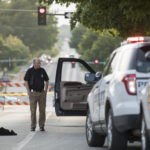Following police shooting, some city leaders call for more police training, data regarding Lawrence traffic stops

photo by: Nick Krug
A detective with the Johnson County Sheriff's office walks around a Ford Excursion that was driven by an individual shot by a police officer at the intersection of Sixth and Vermont streets on Tuesday, May 29, 2018.
After Lawrence police shot a black man last week during an altercation that began with a traffic stop, some city leaders are asking for more training for officers and more data regarding traffic stops of people of color.
Police have said that the man was originally pulled over for a seat-belt violation, a type of infraction that was being policed more heavily as part of a national Click It or Ticket campaign. (Police have not released the man’s identity, but the Journal-World has learned that it was Akira S. “Nell” Lewis, 34, of Lawrence.)
At Tuesday’s City Commission meeting, Commissioner Leslie Soden read a statement saying she was not comfortable approving further Click It or Ticket campaigns, creating a new traffic unit or otherwise increasing traffic patrol until oversight and training conditions were met.
“I very much appreciate what the police force does for our community, but we must better prove to the public that we are addressing over-representation of minority populations in the criminal justice system,” Soden said. “And I would add that we’ve already lost in the court of public opinion as of last week.”
Soden asked the city to implement three conditions. The first was that body cameras be provided to all officers before any further traffic campaigns or increases in traffic enforcement.
The city allocated money in this year’s budget to equip every police officer with a body camera, but the commission has not been given a date for when the camera program will be implemented. The Journal-World previously reported that the goal was to have the cameras in use by the end of the year.
On Wednesday, police Sgt. Amy Rhoads confirmed that time frame.
“We are anticipating the implementation of body worn cameras by the end of 2018,” Rhoads said in an email. “Currently, the policy for our body worn camera policy is still being developed within the framework outlined by the Bureau of Justice Assistance. Once a basic policy is approved by the BJA, we will proceed forward with other aspects of program development, including the receipt of community input.”
As part of an ongoing city staff review of Lawrence’s traffic calming program — which involves controlling or slowing traffic by installing physical devices such as speed bumps and traffic circles — the city will also be considering traffic enforcement levels, which have dropped off significantly in the past decade.
Soden asked as a second condition that race and demographic data collection from all traffic stops — and potentially all contacts with officers — be implemented before any increase in traffic enforcement takes place.
Third, Soden asked that crisis intervention training be provided to all officers, including de-escalating techniques.
The police department has said that improving data collection was one of its goals. Last year, former Police Chief Tarik Khatib told the Journal-World that the department planned to collect more data on law enforcement contact with minorities. Khatib said that as of January 2017 all officers had taken a mental health first-aid class and about half had received a 40-hour Crisis Intervention Team training. He said the goal was to have all officers go through CIT training by 2018. The Journal-World on Wednesday requested an update from the police department regarding those numbers.
Commissioner Jennifer Ananda also read a statement related to the police shooting. Ananda noted that there are a disproportionate number of black residents in the Douglas County Jail as compared with their percentage of the population. Ananda also said the city needed to look at what segments of the population access city services and proactively work to increase minority representation on the city’s advisory boards. Like Soden, Ananda said the city needs to collect data regarding police contact with people of color.
“We have an opportunity here to be the kind of city that can lead other cites and municipalities throughout the state in transparent equitable policy and decision-making,” Ananda said. “We have an opportunity to step outside of the cloak of unconscious and sometimes conscious attitudes and beliefs and systemic racism and sexism and say that enough is enough. We are committed to each member of our community.”
Both Soden and Ananda spoke during the commission items segment, toward the end of the meeting. Mayor Stuart Boley made a statement related to the shooting to open the meeting. Boley noted that the investigation of the shooting has been referred to the Johnson County Sheriff’s Office and that investigation by a third party is the national “best practice.” Boley said in the interest of preserving a thorough and accurate investigation for all involved that the commission cannot provide any comment about the matter until the investigation is concluded. He said the public could make remarks during public comment.
“We understand that a number of citizens are upset and concerned; we want to hear you,” Boley said.
Several people referenced the shooting in comments made during one of the commission’s previously scheduled agenda items, regarding the formation of a community review board for misconduct and bias complaints against police.








COMMENTS